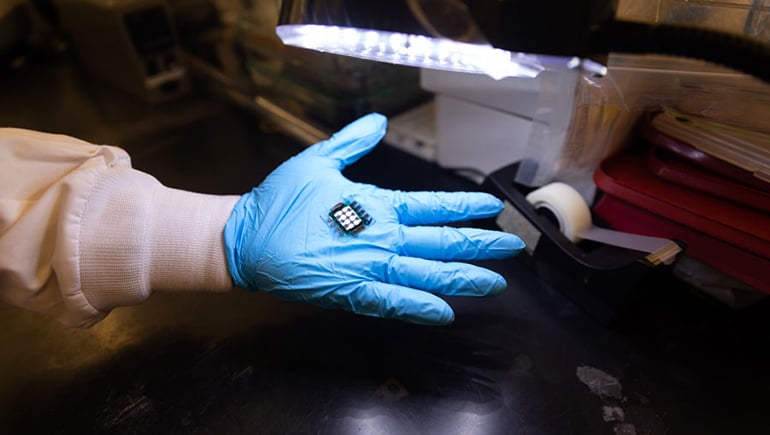NU researchers develop highly efficient tandem solar cell including perovskite material
Photo Courtesy of Aaron Demeter/University of Toronto
A perovskite tandem solar cell. Northwestern researchers co-developed a new cell model that broke records for energy efficiency.
January 26, 2023
Each rainbow features the full range of the electromagnetic spectrum, including wavelengths from red to violet and beyond.
But, these wavelengths can present an obstacle for scientists working to harness energy from the sun.
In response to this challenge, Northwestern researchers have co-developed a “perovskite tandem” solar cell that can better absorb sunlight of all wavelengths. The solar cell has broken records for efficiency.
The research team published its findings on the solar cell in a Nature article last November.
Solar cells — the building blocks for solar panels — absorb energy from sunlight, which excites their electrons into forming an electric current, generating electrical energy. For decades, silicon has been the primary material of solar cells, but scientists have experimented with other substances to increase energy efficiency and lower costs.
Chemistry Prof. Ted Sargent, a co-author of the research paper, and his lab have worked with emerging photovoltaic materials to develop new solar cells for more than a decade, according to chemistry Prof. Bin Chen, a researcher from Sargent’s lab and another paper co-author.
The research group first started studying perovskites, materials containing the same crystal structure as calcium titanium oxide, about nine years ago. Chen said scientists have already improved the efficiency of perovskites to surpass that of silicon-based solar cells.
“Silicon progressed from a little bit below 10% to now 26.7% efficiency in the past five decades,” Chen said. “It only took perovskites less than 10 years to achieve the same thing.”
The lab’s focus on perovskites presented an opportunity to collaborate with paper co-author and chemistry Prof. Mercouri Kanatzidis’ research group, which published research in 2012 on the potential of the materials in manufacturing solar cells.
The two labs developed an efficient perovskite tandem cell in collaboration with researchers from the University of Toronto, University of Toledo and Saudi Arabia’s King Abdullah University of Science and Technology.
Tandem cells consist of two cells with distinct band gaps — or minimum energies required to excite electrons. Each band gap corresponds to a different part of the light spectrum, allowing the tandem cell to produce more energy. Kanatzidis said each additional layer should improve efficiency.
“If you keep (adding cells), the theory says you can reach up to 40, 45, maybe 50% efficiency, which is a dream,” Kanatzidis said.
A frequent problem with tandem cells, however, is that electrons must travel through additional layers when following the electric current, leaving the electrons prone to losing energy in a process known as recombination, Kanatzidis said. The scientists added a propane diammonium coating to the solar cell to reduce recombination and improve energy efficiency.
The National Renewable Energy Laboratory assessed the efficiency of the research team’s cell at 26.29%, which beats the 25.7% efficiency record of single perovskite cells. The cell also reached 27.4% efficiency in the researchers’ lab — a record for a perovskite tandem cell.
But, Kanatzidis and Chen said challenges remain for maximizing the potential of perovskites, primarily their stability.
According to Chen, while silicon solar cells can last for years, the perovskite cell degrades and loses about 10% efficiency after 300 hours of continuous usage. He said the research group is currently working to determine the causes of degradation, in addition to experimenting with other innovations, like triple-junction cells.
Regardless of questions on stability, Chen said the efficiency and cheap cost of perovskites make them a promising material.
In a statement to The Daily, NUsolar, a student organization which designs solar-powered race cars, said the researchers’ findings present exciting possibilities for future models in their field.
“These new cells’ ability to capture a wider range of the EM spectrum will surely prove a great step forward in improving overall solar efficiency,” McCormick junior Matthew Flais, the team’s electrical lead, wrote. “Some time in the future, we may yet see a solar car team power their vehicle with perovskite-based arrays made possible by this work.”
Kanatzidis said scholarship on perovskites and solar cells should continue to be an “exciting” area for inquiry in coming years as scientists make further breakthroughs. He said he hopes his and Sargent’s lab groups will advance “the state of the art” in the field.
Chen said as the world attempts to reduce greenhouse gas emissions, scientists must explore all possibilities for greater solar energy production. Perovskites, he said, will play a large role in that search.
“Net zero is a very hot topic, and then we want to hit the target by 2050,” Chen said. “That requires a massive upscaling of the solar cells.”
Email: russellleung2024@u.northwestern.edu
Twitter: @rjleung7
Related Stories:
— Evanston aims to make more public buildings ‘solar-ready’
— Q&A: Ryan Fellow, NU student Matthew Coile discusses recyclable plastic research



